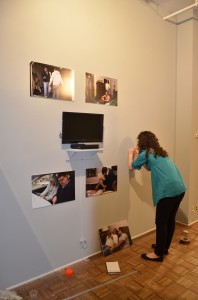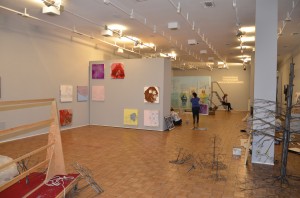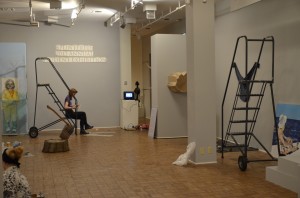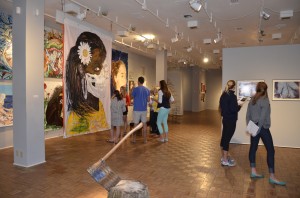Throughout the year, the Samek staff have taken various approaches to generate interest for our exhibitions on the blog. Therefore rather than presenting viewers with facts and figures, I thought it would be fun to share some photos from the student show installation this time around!
Before studying museum practice and theory in college, I never really considered the exhibition process. For instance, did you know that on average it takes the Samek staff about two weeks to entirely change over a show? Perhaps that seems like a long time, but let’s consider what those two weeks entail.
Exhibition change over begins with a week of de-installation. Typically, works from the current exhibition are removed from their displays and securely packaged in crates for shipping. Once the art is safely stored, gallery repairs commence- exhibition lighting is turned off and removed, work lights are turned on, hardware is removed from walls, holes are plastered and primed, and walls are touched up with paint. When the paint dries, the temporary walls are moved into place for the new exhibition and works are brought into the gallery and unpackaged for layout, thereby beginning the week long installation process.
Exhibition installations can vary greatly and are organized according to the works going on display. This year’s student exhibition required the use of a few pedestals and shelves (which had to be painted to match the gallery walls), as well as equipment from IT (which had to be ordered, programmed, and assembled). After all the works were hanged or alternatively displayed, the wall labels, didactic text, and word vinyl were installed. Whew, tired yet?!? Don’t worry, install is almost finished…
Next comes lighting, which requires the use of two ten foot ladders to hang individual light canisters, thus ensuring each work is properly lit. Things to consider during lighting include bulb wattage, the distance between the work and its light, if lights blind viewers (in which case they have to be moved or adjusted), and whether or to not light a work straight on or at an angle. Finally, after the all the lighting issues are sorted, tools and equipment can be picked up and the gallery is cleaned before the exhibition opens.
Thank you for allowing me to share the ins and outs of exhibition change over with you. Perhaps this general knowledge will aid you in critiquing the next exhibition you attend! Please join the gallery staff, art department, and students this evening to celebrate the opening of “Splintered: The 2013 Annual Student Exhibition” with an artist panel from 6-7 in the gallery theater, followed by a reception in the Samek Art Gallery from 7-8.





